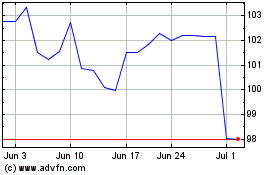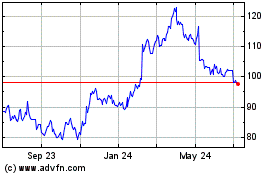For the first time in the 60 years since Disneyland opened, Walt
Disney Co. is considering switching to demand-based pricing at its
domestic parks, where tickets would cost less or provide added
benefits on slower days and cost extra or come with more
restrictions on dates when there tend to be too many people.
"We have to look at ways to spread out our attendance throughout
the year so we can accommodate demand and avoid bursting at the
seams," said Walt Disney Parks and Resorts Chairman Bob Chapek.
Continuing to raise overall prices, as Disney has done well
above the inflation rate for several years, wouldn't fully solve
the problem, said Mr. Chapek, as he is also seeking to raise
attendance during slower times of the year. In addition, for
Disney's brand, keeping park vacations within the reach of
middle-class families is important.
Maintaining the magic at its theme parks is becoming
increasingly challenging for Disney amid crowds drawn by new
attractions, an improving economy and the popularity of franchises
like "Frozen" and "Star Wars." Both Walt Disney World in Orlando,
Fla., and Disneyland in Anaheim, Calif., have posted record
attendance for each of the last three fiscal years, as well as for
the spring quarter that ended in June.
Gruelingly long lines and gate closures, which Disney parks
sometimes have to implement on the busiest days, lead to unhappy
visitors, exactly what the operators of the "Happiest Place on
Earth" want to avoid.
Nikole Zivalich uses her annual pass to go to Disneyland more
than 15 times a year, but has long stayed away on Saturdays, which
are almost always jam-packed with visitors. Now, however, she also
doesn't go within a week of any major holiday and is wary of
Sundays, Fridays and Mondays. On one recent visit Main Street was
so clogged that she was funneled by security behind the scenes,
where she walked by dumpsters and the plywood backs of facades.
"I remember being bummed I had to see a nonmagical part of
Disneyland," said the 28-year-old television producer.
If the company can instead keep Disneyland and Walt Disney World
full but not mobbed for more of the year, that would likely benefit
the bottom line, with spending on food and hotels more than making
up for any ticket price reductions. In the first nine months of the
fiscal year ended in September, Disney's parks and resorts revenue
grew 6% to $11.8 billion and operating income was up 16% to $2.3
billion.
Adjusting prices due to demand is common at hotels and airlines
and Disney itself has long had tiers of annual passes that don't
include admission on certain dates. But for single- or multiday
tickets, the cost has always been the same at its domestic parks
whether one goes on a rainy Wednesday in January or Memorial Day
weekend, save for occasional Disneyland promotions for area
residents.
This week, Disney will begin surveying previous visitors to
gauge their reactions to different variable pricing options. Mr.
Chapek said that finding ways to "steer demand" through ticket
options was critical but that he has no predetermined conclusions
about how exactly the company will do it or when.
Given the way demand-based pricing works in other industries, it
isn't difficult to foresee a time when visiting one of Disney's
parks on a major holiday would cost substantially more than the
current $105 maximum price for a single day adult ticket in Orlando
and $99 in Anaheim. Visiting on a weekday in the winter, by
contrast, could come at a significant discount.
Among the benefits Disney can include with tickets is visiting
different parks in the same location—such as Epcot Center and the
Magic Kingdom at Walt Disney World—on the same day.
The company has offered tiered pricing at Disneyland Paris since
last year, currently ranging from $64 for an adult ticket good only
during "low season" to $94 for one that works year-round. Due in
part to economic conditions, financial results have been stronger
at Disney's two domestic parks recently than the three—soon to be
four—overseas.
In a related initiative, Disney on Sunday revamped its lineup of
annual passes at both Disneyland and Walt Disney World. It added
new options with date restrictions and raised prices about 10% in
Anaheim, where the use of annual passes by local residents is much
more common than in Orlando. The price of a "premier" pass that
allows unlimited visits in both parks is rising more than 30%, to
$1,439 from $1,099.
Disney has been in the midst of a multibillion-dollar expansion
of its domestic parks over the past several years, including the
new Cars Land in Anaheim's California Adventure, a revamp of
Fantasy Land at Orlando's Magic Kingdom, and "Avatar" and "Frozen"
attractions under construction in Orlando. Those help to expand the
parks' capacity, Mr. Chapek noted, but spur even greater increases
in demand, ultimately making the crowding problem worse.
"It's a problem that is going to grow over time as we expand the
size of our parks," he said. Next year, Disney breaks ground in
Orlando and Anaheim on new "Star Wars"-themed areas.
Another tool Disney has been using to manage crowds at its parks
is technology, particularly the new My Magic Plus wristbands that
let Disney World visitors reserve times for certain rides and meals
before their arrival. That has increased capacity at the Magic
Kingdom by 5,000 people, said Disney Parks & Resorts finance
chief Spencer Neumann.
Write to Ben Fritz at ben.fritz@wsj.com
Access Investor Kit for "CitiGroup Inc"
Visit
http://www.companyspotlight.com/partner?cp_code=P479&isin=US1729674242
Subscribe to WSJ: http://online.wsj.com?mod=djnwires
(END) Dow Jones Newswires
October 04, 2015 20:55 ET (00:55 GMT)
Copyright (c) 2015 Dow Jones & Company, Inc.
Walt Disney (NYSE:DIS)
Historical Stock Chart
From Mar 2024 to Apr 2024

Walt Disney (NYSE:DIS)
Historical Stock Chart
From Apr 2023 to Apr 2024
